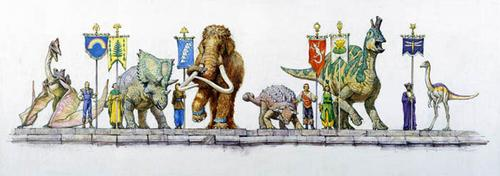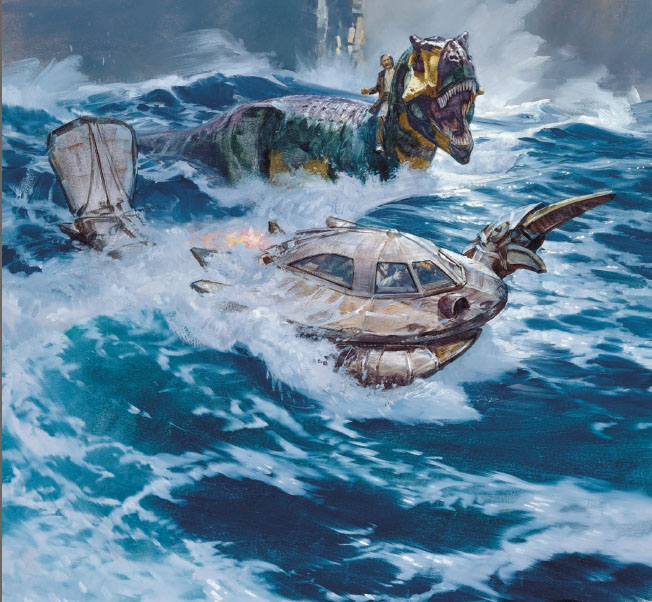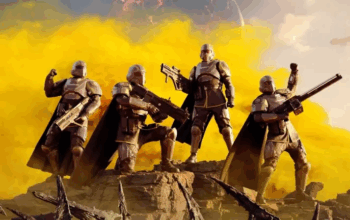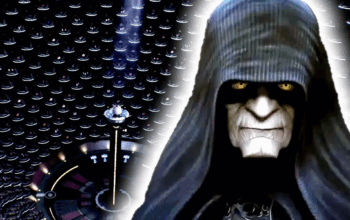This is part 2/3 of our series exploring what our version of a “Dinotopia” miniseries would look like – read part 1 here!
Part 2: Our Miniseries
On with the elevator pitch…
So the main difference between this pitch and the Hallmark series is that ours is set in the same period as the books, focusing on the original characters as they were in 1863. However, the main difference from the books is that we can see through flashbacks to what Arthur and Will Denison’s characters were like before their voyage (akin to Abrams’ Lost). It should be given the deep world-building of Avatar: the Last Airbender with the gradual seriousness of Harry Potter and His Dark Materials as the show goes on. We’re envisioning a cap of 4 seasons, 8-10 episodes long, with individual episode lengths dependent on the budget constraints, narrative flow, and source material capacity. (In other words, best served via streaming service)
Another goal we’re aiming to reach is the notion of self-contained stories from season to season. This is mostly born out of a major pet peeve of ours: promising shows ending on a cliffhanger due to cancellation. This is a problem that often occurs with mid-high budget TV is that without a chance to develop a strong core fanbase, ending up cancelled in 2 seasons or less (RIP, Firefly) and leaving everyone disappointed. We want to showcase this world in distinct self-contained arcs, showing off the lands, characters, and stories of the book series in a way that leaves us satisfied when a studio inevitably pulls the plug on season 3 due to the production price tag and the realities of selling a dinosaur series to adults and children alike.
Season 1 – Welcome to Dinotopia
Our first season should aim to sell the world of Dinotopia to new audiences over the course of 8 to 10 episodes, as this gives more time to explore both the characters and the world they live in. The first book was written more as a first-person diary than a traditional 3-act structure, spanning over the course of a year chronicling what sites father and son visited throughout the island. The focus of the first book leaned much further towards world building more than characters (as one would imagine when a book is written by a conceptual artist).
The focus of this season should be on Arthur’s conflicted feelings about exploring yet missing the rest of the world. In stark contrast we’ll see Arthur’s son, Will Denison, eagerly embracing his new life. To capture not only the characters but the world of Dinotopia, there needs to be a delicate balance of world-building and character development for this series to resonate with fans while drawing in new audiences.
For the sake of keeping our initial seasons self-contained as well as attracting new audiences, our this first season should be designed to be as episodic as possible. Initially, we’ll concentrate on the first book, which focuses on Arthur’s conflicted views exploring the island while showcasing Will’s effort to fly as a Skybax rider. This works out well with the existing book format, as there was a point where Arthur disappears just like Gandalf in The Hobbit only for the films to explore where he went. This presents a clear opportunity to cleanly show more original ideas and characters with Arthur when he was separated from his son’s narrative. The epilogue of the first book even caters to this nicely with a scene where Arthur first entered “The World Beneath” before being driven out – this could form the basis of what’s to come in the 2nd season, while still presenting a clean break for a self-contained story.
Season 2 – It Gets Deeper
This season would follow the story of the second book titled The World Beneath. This book had more of a 3-act structure with Arthur, Lee Crabb, Binx, and Oriana venturing into the Islands deep underworld to understand the true history of Dinotopia. They would be assisted by the Islands Predatory Dinosaurs that Roamed the Jungles Known as the Rainy Basin. who have their own hierarchy led by the king of the predators, a Giganotosaurus named Stinktooth.
Inside “the world beneath” is where they discover hidden secrets of Dinotopia’s past, alongside some creative steampunk tech. There once was an advanced civilization that once ruled Dinotopia from the civilization of Posidos that used dinosaur-shaped mechanical vehicles called strutters that were abandoned when Posidos fell beneath the waves.
This book’s climax erupts when Crabb steals the island’s magical McGuffin, the Ruby Sunstone that is the source of all life on the island, which the predators ironically guard. Arthur chases Lee to the edge of the Razor Reef on the back of Sticktooth with Lee piloting a scorpion strutter. Appropriately enough, this will blow the entire budget for the whole season/series, and make the perfect studio pitch for more funding for our third season.
Season 3 – Microcultures Inside Microcultures
Our third season is based on the third book: Journey to Chandara. In this season Arthur receives an invitation by the ruler of the city Chandara, a mysterious civilization that once ruled much of Dinotopia which now cuts itself off from the rest of the island. This is an opportunity to explore the different civilizations that inhabit the island.
Settlements we’ve seen before in the series like Waterfall City have something of an Aztec or mesoamerican-like appearance, compared to other cities like Sauropodlis and Chandara that have a more Greko-Roman look. James Gurney applied a lot of ancient Human history and architecture on the island and presents us with an avenue for extended world-building. Its clear that different people from across the world at various periods have settled on this island. Some of the inhabitants can still speak ancient Greek, Hittite, and Latin. Something I would explore further in season 4.
Season 4 – Everything Ends(?)
Our final season is meant to break from the books and present an entirely original resolution to all these characters, whose fates are not concluded in the books. This also gives space to create and present ideas not fully covered in the books and use a little bit of the imagination in a world as different as Dinotopia inspires.
One particular idea we’d like to explore is the possibility of the island periodically moving from one place on earth to another around the world. It would explain why so many people from across the world from so many time periods have found their way to the island. The theme of this season is that the island is collecting the best of all human civilizations combining them with the magnificence of the creatures the planet earth has ever known. The moral conflict that our characters face is leaving the island and risking bringing the modern world to them, sullying this new world.
Another idea worth exploring revolves around the king of Posidos, known as “Ogthar”, who is depicted in legend as half-man half-triceratops. For this version I would like to give Ogthar a larger overarching story, giving him a benevolent immortal god-like status. The way the ancient Greeks believed Zeus controls their lives.
Design Aesthetics
As for the dinosaurs themselves there will be a focus on both practical and CG as how it should be with like they did on the Jurassic Park movies. In terms of appearance, instead of giving them an updated scientific look they would look as close to their illustrated counterparts as possible (so no feathered T-Rex). However in the later books Gurney would include newer feathered Dinosaurs such as Therizinasuaurs and the four winged Microraptor.
One detail I must emphasize is that the dinosaurs themselves won’t be specifically named by anyone in the series except Arthur and maybe some of the island’s more recent settlers since during the timeline of the book in 1863 dinosaurs were only begging to be discovered and understood and identified. and even then they looked different from the deceptions today. Being an educated man, Denison would no doubt have heard of dinosaurs but had little understanding of them until his shipwreck, so there won’t be name-dropping Brachiosaurus, Triceratops, or T-Rex – those names wouldn’t be dropped for another 50 years.
I also want to expand on these characters. In the books, they were effectively blank slats as stand-ins for the audience. It’s the animals and the world that the story revolves around. But in every story, there needs to be 3-dimensional characters for people to route for. This is a subject that I’ll discuss in my next article…
But who should we hire to portray our vision? Read part 3 here!









One thought on “Dinotopia Reimagined – Our Version, Our Story”
Comments are closed.